#Data Center Storage Size
Explore tagged Tumblr posts
Text
Data Center Storage Comprehensive Study with Key Trends, Major Drivers and Challenges

Data Center Storage Market Information
The Data Center Storage Market Report provides essential insights for business strategists, offering a comprehensive overview of industry trends and growth projections. It includes detailed historical and future data on costs, revenues, supply, and demand, where applicable. The report features an in-depth analysis of the value chain and distributor networks.
Employing various analytical techniques such as SWOT analysis, Porter’s Five Forces analysis, and feasibility studies, the report offers a thorough understanding of competitive dynamics, the risk of substitutes and new entrants, and identifies strengths, challenges, and business opportunities. This detailed assessment covers current patterns, driving factors, limitations, emerging developments, and high-growth areas, aiding stakeholders in making informed strategic decisions based on both current and future market trends. Additionally, the report includes an examination of the Automatic Rising Arm Barriers sector and its key opportunities.
According to Straits Research, the global Data Center Storage market size was valued at USD XX Billion in 2023. It is projected to reach from USD XX Billion in 2024 to USD XX Billion by 2032, growing at a CAGR of 4.4% during the forecast period (2024–2032).
Get Free Request Sample Report @ https://straitsresearch.com/report/data-center-storage-market/request-sample
TOP Key Industry Players of the Data Center Storage Market
Dell Technologies
IBM Corporation
Buffalo
Hewlett Packard Enterprise Company
FADU
Huawei Technologies Co.LTD.
IBM Corporation
Hitachi Vantara.
Intel
Lenovo
Oracle Corporation
NEC
Toshiba
Violin
Samsung Electronics
ZOTAC.
Global Data Center Storage Market: Segmentation
As a result of the Data Center Storage market segmentation, the market is divided into sub-segments based on product type, application, as well as regional and country-level forecasts.
By Storage Architecture
NAS
SAN
DAS
By Storage Type
Traditional Storage
All-Flash Storage
Hybrid Storage
By End-User
Cloud/IT Sector
BFSI Sector
Government Sector
Other Sectors
Browse Full Report and TOC @ https://straitsresearch.com/report/data-center-storage-market/request-sample
Reasons for Buying This Report:
Provides an analysis of the evolving competitive landscape of the Automatic Rising Arm Barriers market.
Offers analytical insights and strategic planning guidance to support informed business decisions.
Highlights key market dynamics, including drivers, restraints, emerging trends, developments, and opportunities.
Includes market estimates by region and profiles of various industry stakeholders.
Aids in understanding critical market segments.
Delivers extensive data on trends that could impact market growth.
Research Methodology:
Utilizes a robust methodology involving data triangulation with top-down and bottom-up approaches.
Validates market estimates through primary research with key stakeholders.
Estimates market size and forecasts for different segments at global, regional, and country levels using reliable published sources and stakeholder interviews.
About Straits Research
Straits Research is dedicated to providing businesses with the highest quality market research services. With a team of experienced researchers and analysts, we strive to deliver insightful and actionable data that helps our clients make informed decisions about their industry and market. Our customized approach allows us to tailor our research to each client's specific needs and goals, ensuring that they receive the most relevant and valuable insights.
Contact Us
Email: [email protected]
Address: 825 3rd Avenue, New York, NY, USA, 10022
Tel: UK: +44 203 695 0070, USA: +1 646 905 0080
#Data Center Storage#Data Center Storage Industry#Data Center Storage Share#Data Center Storage Size#Data Center Storage Trends#Data Center Storage Regional Analysis#Data Center Storage Growth Rate
0 notes
Text
Hi yes I would like to start down this rabbit hole please because I'm totally normal about this ... I am convinced Jon and Martin are part of a tape drive. It links with the tapes from TMA and the trailer for TMP especially with the opening computer screen (I already posted about my thoughts on that).
What is a tape drive?
A tape drive is a device that stores computer data on magnetic tape, especially for backup and archiving purposes. Like an ordinary tape recorder, a tape drive records data on a loop of flexible celluloidlike material that can be read and also erased.
Tape drives differ from hard disk drives (HDDs) and solid-state drives (SSDs) in the way data is read and written to the storage media. Tapes store data sequentially, whereas HDDs and SSDs use rotating disks with rapidly moving seek heads, nonmoving flash memory or similar technology to transfer data.
Drives come in many sizes and capabilities. They are sold as standalone units or stacked in data center racks, creating tape libraries. The tapes themselves are often housed in sealed cassettes that can be inserted into the drive and activated.
There are several benefits to using tape drives, particularly for backup and archival uses. They include the following:
Capacity. Tapes have a large capacity for storing data when compared to HDDs.
Low cost. They are economical when compared to other storage media.
Life span. Tapes stored in a suitable environment can last for decades, an important factor for archival storage.
Transportable. Tapes can be easily moved from one location to another and are considered off-line storage.
Disaster recovery. Tape is often the storage medium of choice for data backup and DR. Storing critical systems and data on tape creates an air gap between systems that are at risk from cyber attacks simply by removing the tape cassette from the drive.
Security. Today, tapes support encryption such as Advanced Encryption Standard-256 and provide varying levels of data protection.
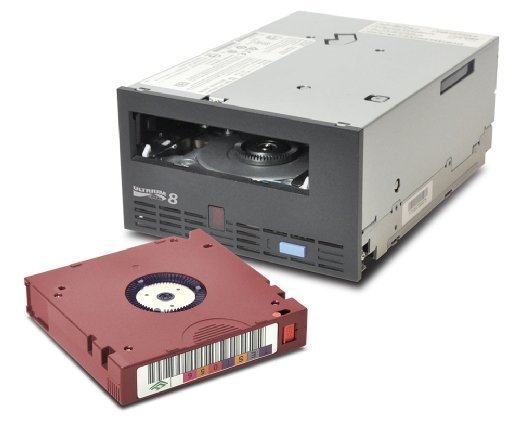
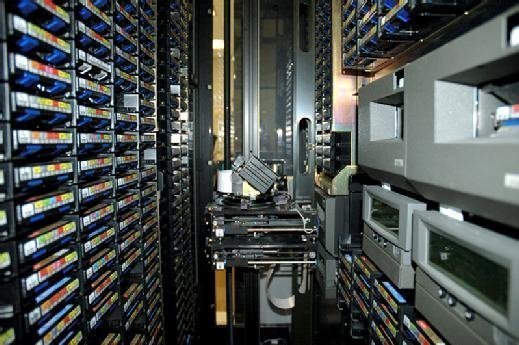

#the magnus archives#martin blackwood#jonathan sims#tma#jonmartin#the magnus protocol#magnus pod#tmp#tmp theory#jon sims#jmart#jonny sims#tape drive#tapes!#jmart is in the tapes!
191 notes
·
View notes
Text
Excerpt from this New York Times story:
In the weeks since President Trump has taken office, he has pushed to unleash oil and gas production and has signed executive orders halting the country’s transition to renewable energy.
But in Washington State, a government-led effort has just started to build what is expected to be the country’s largest solar generating station. The project is finally inching forward, after decades of cleaning up radioactive and chemical waste in fits and starts, at the Hanford Nuclear Reservation, a sweep of desert that was pivotal to the nation’s weapons arsenal from 1943 until it was shut down in 1989. A developer, Hecate, was brought on last year to turn big stretches of the site into solar farms.
Hecate will have access to 10,300 acres that the government has determined sufficiently safe to redevelop. The company has already started site evaluation on 8,000 acres, an area nearly 10 times the size of Central Park in New York and enough space for 3.45 million photovoltaic panels. (Hanford’s site is nearly 400,000 acres.)
If all goes according to plan, the Hecate project, which is expected to be completed in 2030, will be by far the largest site the government has cleaned up and converted from land that had been used for nuclear research, weapons and waste storage. It is expected to generate up to 2,000 megawatts of electricity — enough roughly to supply all the homes in Seattle, San Francisco, and Denver — and store 2,000 more in a large battery installation at a total cost of $4 billion. The photovoltaic panels and batteries will provide twice as much energy as a conventional nuclear power plant. The nation’s current biggest solar plant, the Copper Mountain Solar Facility in Nevada, can generate up to 802 megawatts of energy.
The big unknown still hanging over the plan is whether the Trump administration will thwart efforts that the Biden administration put in place to develop more clean electricity generation.
While a clean energy project may clash with Mr. Trump’s policies, there’s a reason the administration may allow Hecate’s solar development to move forward: the revenue the government will get for the land lease. Hecate and the Energy Department declined to discuss the land’s market value, but private solar developers in the region said such easements typically paid landowners $300 an acre annually.
Two officials at the Energy Department, who asked not to be named for fear of retaliation, said that neither the president nor the leaders of the administration’s effort to reshape federal agencies had yet to intervene in the solar project, but that the future of the initiative was uncertain. One of the officials said the new energy secretary, Chris Wright, a former oil executive, had not yet reviewed the project as of late February.
Alex Pugh, Hecate’s director of development, said the company was moving ahead despite shifting political winds. “The fundamentals of the project are strong regardless of policy direction,” he said. “The region needs the project. There is a huge demand for electricity here.”
Demand for power in the Pacific Northwest is increasing as more data centers are being built to power artificial intelligence. Businesses in the cities closest to Hanford — Kennewick, Pasco and Richland — and organizations pushing for job creation in the region formed the Tri-City Development Council, which has been encouraging clean energy and other environmentally safe industrial development on the federal reservation.
Hecate identified the large expanse of open ground alongside high-voltage transmission lines at Hanford as a potential site for its plant several years ago, Mr. Pugh said — long before the Energy Department solicited proposals. The potential benefits, he said, were plainly apparent.
9 notes
·
View notes
Text

Evelyn Berezin in 1976 at the Long Island office of her company Redactron. She developed one of the earliest word processors and helped usher in a technological revolution. Evelyn Berezin said her word processor would help secretaries become more efficient at their jobs. Photo By Barton Silverman/New York Times.
Evelyn Berezin, “Godmother of the Word Processor!” The Woman That Made Bill Gates and Steve Jobs Possible
Evelyn Berezin (1925-2018) was born in the Bronx to poor Russian-Jewish immigrants. Growing up, she loved reading science fiction and wished to study physics. She excelled at school and graduated two years early. Berezin had to wear make-up and fake her age to get a job at a research lab. She ended up studying economics because it was a more “fitting” subject for women at the time. During World War II, she finally received a scholarship to study physics at New York University. Berezin studied at night, while working full time at the International Printing Company during the day. She continued doing graduate work at New York University, with a fellowship from the US Atomic Energy Commission. In 1951, she joined the Electronic Computer Corporation, designing some of the world’s very first computers. At the time, computers were massive machines that could only do several specific functions.

Evelyn Berezin, “Godmother of the Word Processor.” Born: April 12, 1925, The Bronx, New York City, NY — Died: December 8, 2018, ArchCare at Mary Manning Walsh Nursing Home & Rehabilitation Center, New York, NY
Berezin headed the Logic Design Department, and came up with a computer to manage the distribution of magazines, and to calculate firing distances for US Army artillery. In 1957, Berezin transferred to work at Teleregister, where she designed the first banking computer and the first computerized airline reservation system (linking computers in 60 cities, and never failing once in the 11 years that it ran). Her most famous feat was in 1968 when she created the world’s first personal word processor to ease the plight of secretaries (then making up 6% of the workforce).
“Without Ms. Berezin There Would Be No Bill Gates, No Steve Jobs, No Internet, No Word Processors, No Spreadsheets; Nothing That Remotely Connects Business With The 21st Century.” — The Times of Israel (12 December 2018)
The following year, she founded her own company, Redactron Corporation, and built a mini-fridge-sized word processor, the “Data Secretary”, with a keyboard and printer, cassette tapes for memory storage, and no screen. With the ability to go back and edit text, cut and paste, and print multiple copies at once, Berezin’s computer freed the world “from the shackles of the typewriter”. The machine was an in instant hit, selling thousands of units around the world. Berezin’s word processor not only set the stage for future word processing software, like Microsoft Word, but for compact personal computers in general. It is credited with being the world’s first office computer. Not surprisingly, it has been said that without Evelyn Berezin “there would have been no Bill Gates, and no Steve Jobs”.

Evelyn Berezin Pioneered Word Processors and Butted Heads With Men! A ‘loud woman,’ she studied physics and found that to get to the top she had to start her own company. Evelyn Berezin later became a mentor to entrepreneurs, venture capitalist and director of companies. Photo: Berezin Family. Wall Street Journal
“Why Is This Woman Not Famous?” British Writer Gwyn Headley Wrote In A 2010 Blog Post. — The Times of Israel
Redactron grew to a public company with over 500 employees. As president, she was the only woman heading a corporation in the US at the time, and was described as the “Most Senior Businesswoman in the United States”. Redactron was eventually bought out by Burroughs Corporation, where Berezin worked for several more years. In 1980, she moved on to head a venture capital group investing in new technologies. Berezin served on the boards of a number of organizations, including Stony Brook University and the Brookhaven National Laboratory, and was a sought-after consultant for the world’s biggest tech companies.
She was a key part of the American Women’s Economic Development Corporation for 25 years, training thousands of women in how to start businesses of their own, with a success rate of over 60%. In honour of her parents, she established the Sam and Rose Berezin Endowed Scholarship, paying tuition in full for an undergraduate science student each year. Sadly, Berezin passed away earlier this month. She left her estate to fund a new professorship or research centre at Stony Brook University. Berezin won multiple awards and honourary degrees, and was inducted into the Women in Technology International Hall of Fame.
#Evelyn Berezin#Business & Finance#Science & Technology#Steve Jobs#Bill Gates#Computers#Computer Science#Microsoft Word#New York University#Physics#Teleregister#Word Processor#WWII#Redactron#Belarusian 🇧🇾 Russian 🇷🇺 Jewish
11 notes
·
View notes
Text
Why False Flooring is Essential (needed) for Data Centers and IT Infrastructure
Data centers serve as the backbone for any enterprise of substantial size in the advanced digital world today. As enterprises have increased their reliance and dependency on technology, it has therefore become essential for them to ensure the safety, efficiency, and extensibility of their IT infrastructure. One of the most valuable—but often overlooked—items that preserve this ecosystem is false flooring (also referred to as raised access flooring).
What is false flooring?
False flooring is a modular floor system placed on top of the original concrete slab that encloses a plenum or space for necessary services to be run. This space is used to run power cables, data wiring, cooling systems, or any number of devices while having the floor visible and functional.
💡 Reasons Data Centers Require False Floors
1. Effective Cable Management
Data centers have many thousands of servers, switches, and storage systems, and false floors provide you with organized cabling options from power cables and data cables to keep them neat and tidy while eliminating potential trip hazards and the burden of potential maintenance.
2. Improve Cooling and Airflow
A raised access floor is used to distribute cold air from below the raised false floor with airflow panels. It is essential to make cooling as effective as it can be by targeting racks or hot spots to keep areas cool and to reduce equipment failure from overheating.
3. Easy Scalability or Flexibility
Technology changes rapidly, and with this comes changes to cabling infrastructure needs. With a raised floorong you have easy access to cabling and components if you need to upgrade, change, or fix something without statically disturbing service within the facility.
4. Safety and Fire Safety
With everything neatly routed through the floor space, you will not have potential electrical safety hazards. Most raised false floor systems have some type of flame retardant feature to offer higher safety levels in critical facilities.
5. Aesthetics and Organization
Having a clean space free of clutter isn't just about appearances, it's about being able to efficiently work or service equipment when necessary. The raised floor hides unsightly arranging of wiring and HVAC systems to present a more organized and professional looking facility.🧱 Best Panel Types for IT & Data Center Use/best false flooring manufactures for data center.
HPL Panels – Durable, anti-static, and ideal for heavy equipment loads.
Airflow Panels – Perforated tiles for cooling airflow.
Vision Panels – Allow visual inspection of the subfloor without removal.
Bare Panels – Cost-effective for internal or unfinished environments.

📍 Conclusion
False flooring is more than just a technical solution, it is a tactical investment for any data center or IT operation. Whether you're containing heat and cables or quickly reconfiguring the IT infrastructure, raised access floors contribute to efficiency, safety and operational continuity.
In the next few years if your plans are to build a data center or upgrade your IT infrastructure consider that you need a viable false flooring system that meets your needs. For more info visit www.yemag.co.in
2 notes
·
View notes
Text
Strategic Analysis of the Hard Disk Market Growth Trends & Regional Breakdown
In an age where data is the new oil, the hard disk drive (HDD) market plays a critical role in data storage infrastructure. Despite the rapid rise of solid-state drives (SSDs), HDDs continue to hold strong in certain sectors due to their cost-efficiency, large capacity, and ongoing technological improvements.
Market Snapshot
According to Market Research Future, the global hard disk market size was valued at USD 58.84 billion in 2023 and is projected to grow from USD 62.43 billion in 2024 to USD 100.26 billion by 2032, exhibiting a compound annual growth rate (CAGR) of 6.10% during the forecast period (2024–2032).
Sample Link: https://www.marketresearchfuture.com/sample_request/8306
While consumer demand is shifting toward faster SSDs, HDDs remain dominant in data centers, surveillance systems, and archival storage where capacity outweighs speed.
Key Players
Seagate Technology
Western Digital
Toshiba
HGST (a Western Digital subsidiary)
These companies continue to innovate in terms of higher storage capacities, Helium-filled drives, and energy-assisted magnetic recording technologies.
Trends Shaping the HDD Market
1. High-Capacity Drives on the Rise
The industry is moving toward 20TB and above drives, driven by hyperscale data centers that require vast amounts of storage for cloud services, AI training, and video content.
2. Shift to Enterprise Applications
While consumer use of HDDs is declining, enterprise adoption is strong. Cloud service providers and large-scale enterprises prefer HDDs for cold data storage, where infrequent access makes cost per GB the deciding factor.
3. Hybrid Storage Solutions
Many IT environments now use a hybrid model: SSDs for performance and HDDs for capacity. This coexistence supports HDD demand in large-scale environments.
Challenges Ahead
Competition from SSDs
The falling price of SSDs, along with their performance benefits, has eroded HDD demand in laptops, desktops, and gaming consoles.
Supply Chain Disruptions
The market is still feeling the effects of COVID-19 and geopolitical tensions, which have impacted manufacturing and logistics, especially in Asia-Pacific regions.
Environmental Concerns
HDDs, being mechanical, consume more power and are less environmentally friendly than SSDs. This has prompted some data centers to seek greener alternatives.
Regional Insights
Asia-Pacific leads in manufacturing and consumption, particularly in China and India, driven by rapid digital transformation.
North America shows stable enterprise demand, especially in cloud computing.
Europe is increasingly investing in data center expansion and green storage solutions.
Future Outlook
While HDDs won’t dominate forever, they still have a vital role in the tiered storage ecosystem. The future will likely see:
Continued push for energy-efficient and ultra-high-capacity drives
Innovations in HAMR (Heat-Assisted Magnetic Recording) and MAMR (Microwave-Assisted Magnetic Recording)
Strategic alliances between HDD and cloud storage providers
Related Trending Reports
Lcd Panel Market
Led Tube Market
Odor Sensor Market
Seven Segment Display Market
Speakerphones Market
Flexible Hybrid Electronics Market
Datacenter Chip Market
Robotic Window Cleaners Market
Artificial Intelligence Sensor Market
Electric Vehicle Parts and Components Market
1 note
·
View note
Text
Petalhost: The Best Magento Hosting Provider in India
When it comes to hosting your Magento-based ecommerce website, you need a hosting provider that ensures speed, reliability, and scalability. Petalhost emerges as the most trusted Magento Hosting Provider in India, offering cutting-edge hosting solutions designed specifically for Magento-powered online stores.
Why Choose Petalhost for Magento Hosting?
Magento is a robust ecommerce platform that demands high-performance hosting to deliver a seamless shopping experience. Petalhost understands these unique requirements and provides tailored hosting solutions that guarantee optimal performance and security for your Magento website.
1. High-Speed Servers for Lightning-Fast Performance
Slow-loading websites can drive customers away, but with Petalhost’s high-speed SSD-powered servers, your Magento store will load in the blink of an eye. This not only enhances user experience but also improves search engine rankings, ensuring more visibility for your online store.
2. 99.9% Uptime Guarantee
Downtime means lost sales and damaged customer trust. Petalhost guarantees 99.9% uptime, ensuring your Magento store remains accessible around the clock. Their state-of-the-art data centers are equipped with the latest technology to ensure uninterrupted service.
3. Robust Security Features
Ecommerce websites handle sensitive customer data, making security a top priority. Petalhost provides advanced security measures such as firewalls, DDoS protection, malware scanning, and free SSL certificates to safeguard your Magento store and protect customer information.
4. Optimized for Magento
Petalhost’s servers are specifically optimized for Magento, providing pre-configured setups that reduce the need for manual adjustments. This ensures your website runs smoothly and efficiently, regardless of traffic spikes or complex integrations.
5. Scalable Hosting Plans
As your business grows, so do your hosting requirements. Petalhost offers scalable hosting plans that allow you to upgrade your resources seamlessly without any downtime. Whether you’re running a small store or managing a large ecommerce enterprise, Petalhost has the perfect hosting solution for you.
6. 24/7 Expert Support
Petalhost’s team of Magento hosting experts is available 24/7 to assist you with any issues or queries. From initial setup to ongoing maintenance, their friendly and knowledgeable support team ensures you’re never alone.
Key Features of Petalhost’s Magento Hosting Plans
SSD Storage: High-speed solid-state drives for faster data retrieval.
Free SSL Certificate: Secure your store and build customer trust.
Daily Backups: Keep your data safe with automated daily backups.
One-Click Installation: Quickly set up your Magento store with an easy installation process.
Global Data Centers: Choose from multiple data centers for optimal performance and reduced latency.
Developer-Friendly Tools: Access SSH, Git, and other developer tools for seamless store management.
Affordable Pricing for Every Budget
Petalhost believes in offering premium Magento hosting solutions at affordable prices. Their hosting plans are designed to suit businesses of all sizes, from startups to established enterprises. With transparent pricing and no hidden fees, you get the best value for your money.
Why Magento Hosting Matters
Magento is a feature-rich platform that enables businesses to create highly customizable and scalable online stores. However, its powerful features also demand a hosting environment that can handle its resource-intensive nature. A reliable Magento hosting provider like Petalhost ensures that your website runs efficiently, providing a smooth shopping experience for your customers and boosting your online sales.
How to Get Started with Petalhost
Getting started with Petalhost’s Magento hosting is quick and hassle-free. Simply visit their website, choose a hosting plan that suits your needs, and follow the easy signup process. Their team will guide you through the setup and migration process to ensure a smooth transition.
Conclusion
If you’re looking for a reliable and affordable Magento Hosting Provider in India, Petalhost is the name you can trust. With high-speed servers, robust security, and dedicated support, Petalhost provides everything you need to run a successful Magento-based ecommerce store. Don’t let subpar hosting hold your business back. Choose Petalhost and take your online store to new heights today!
2 notes
·
View notes
Text
Buy Hosting UAE: Reliable Web Hosting Solutions for Your Business
Buy hosting UAE to secure high-performance, reliable, and affordable web hosting services tailored to meet your business needs. A robust hosting solution is critical for ensuring your website’s speed, uptime, and security, enabling you to provide an exceptional user experience and maintain a strong online presence.
Web hosting providers in the UAE offer a variety of plans, including shared hosting, VPS hosting, dedicated servers, and cloud hosting, to cater to businesses of all sizes. These services are designed to deliver optimal performance, with features like unlimited bandwidth, SSD storage, and advanced security protocols.
When you choose to buy hosting in the UAE, you gain access to local data centers, ensuring faster website load times and enhanced connectivity for your target audience. Additionally, UAE-based hosting services comply with regional regulations, making them a secure and reliable choice for businesses operating in the region.
A professional hosting service includes round-the-clock technical support, easy scalability, and user-friendly control panels, allowing you to efficiently manage your website. Whether you’re launching a new website, running an e-commerce store, or scaling up a growing business, reliable hosting ensures your site remains operational and secure at all times.
Investing in a trusted web hosting provider in the UAE is key to optimizing your website’s performance and safeguarding your digital assets. With a focus on speed, security, and support, hosting services in the UAE empower businesses to thrive in the competitive online landscape. Buy hosting UAE today to unlock the full potential of your website and deliver an outstanding online experience for your customers.
2 notes
·
View notes
Text
USA Dedicated Server: The Ultimate Solution for Your Hosting Needs

In the world of web hosting, having a robust, reliable, and fast server is crucial to ensuring the performance of your website or business. Whether you’re running a large-scale business, an e-commerce platform, or a gaming server, your choice of hosting server plays a vital role in the success of your online presence. If you’re looking for high-performance hosting with complete control and flexibility, a USA Dedicated Server is an excellent choice.
DigiRDP offers an array of hosting solutions, including USA Dedicated Servers and Cloud VPS hosting, to provide the reliability, speed, and scalability you need to run your websites, applications, and more. In this article, we will explore the benefits of choosing a USA Dedicated Server, particularly for those looking for Dallas Budget Servers and Cloud VPS options, to help you make an informed decision about your hosting needs.
What is a USA Dedicated Server?
A USA Dedicated Server is a physical server that is entirely dedicated to hosting your website, application, or service. Unlike shared hosting or virtual private servers (VPS), where multiple users share the same server resources, a dedicated server provides you with exclusive access to all the resources, such as CPU, RAM, storage, and bandwidth.
DigiRDP offers premium USA Dedicated Servers, ensuring that businesses of all sizes can enjoy unparalleled performance, security, and uptime. These servers are based in data centers located throughout the United States, providing low-latency connections and fast data transfer speeds for users across the globe.
Why Choose a USA Dedicated Server?
When it comes to hosting your website or applications, the server location can play a significant role in the speed and reliability of your service. Choosing a USA Dedicated Server offers several key benefits:
1. High Performance and Speed
Dedicated servers are built for performance. With all resources reserved for your use, you don’t have to worry about other users affecting your server’s performance. A USA Dedicated Server ensures that your website or application loads quickly, providing a seamless user experience. This is particularly important for businesses that rely on their online presence, such as e-commerce websites or platforms with high traffic volumes.
2. Full Control and Customization
With a dedicated server, you have full control over the server configuration, including the operating system, software, and security settings. This means you can optimize the server for your specific needs, install the software you require, and configure the server exactly how you want it.
DigiRDP’s USA Dedicated Servers give you the freedom to customize everything from the hardware to the operating system, ensuring that your server is tailored to the unique needs of your business.
3. Reliability and Security
Dedicated servers offer superior reliability and security compared to shared hosting or VPS options. Since you’re the only user on the server, you don’t have to worry about other websites causing performance issues or compromising security. Dedicated servers are ideal for handling sensitive data and high-traffic websites that require maximum uptime and protection.
4. Scalability
As your business grows, your hosting needs will evolve. USA Dedicated Servers offer excellent scalability, allowing you to easily upgrade resources such as storage, RAM, or CPU power. DigiRDP provides flexible hosting plans that can grow with your business, making it easy to scale your hosting environment as needed.
Dallas Budget Servers: The Perfect Solution for Cost-Effective Hosting
For businesses on a budget, Dallas Budget Servers are an ideal choice. Dallas is home to some of the best data centers in the United States, providing high-quality infrastructure at competitive prices. DigiRDP’s Dallas Budget Servers offer powerful hardware and reliable performance without the high price tag typically associated with dedicated hosting.
Benefits of Dallas Budget Servers:
Cost-Effective Hosting: Dallas is known for its affordable data center services, and DigiRDP offers Dallas Budget Servers that provide excellent value for money. These servers are ideal for small to medium-sized businesses that require a reliable hosting solution without breaking the bank.
Low Latency for US Traffic: Hosting your server in Dallas ensures that your website or application will have low latency for users in the United States. This leads to faster load times and improved user experience for your American audience.
24/7 Support: DigiRDP offers round-the-clock customer support for its Dallas Budget Servers, ensuring that your hosting environment remains stable and secure at all times. Whether you need technical assistance or have a question about your server configuration, DigiRDP’s expert team is always available to help.
What You Get with DigiRDP’s Dallas Budget Servers:
Affordable pricing without compromising on quality
Reliable performance for small to medium-sized businesses
Expert customer support and management options
High-performance hardware and networking infrastructure
Fast and reliable connectivity for US-based users
Cloud VPS: Scalable and Flexible Hosting
While a USA Dedicated Server offers complete control over your hosting environment, it may not be the best fit for businesses that need more flexibility or are just getting started. In such cases, a Cloud VPS (Virtual Private Server) could be the perfect alternative.
A Cloud VPS offers many of the benefits of a dedicated server but with more scalability and flexibility. Instead of relying on a single physical server, a Cloud VPS leverages the power of multiple virtualized servers. This makes it easier to scale your resources on demand, without the need for physical hardware upgrades.
Benefits of Cloud VPS Hosting:
Scalability: As your business grows, a Dallas Cloud VPS allows you to easily scale your resources, such as storage, CPU power, and RAM, with just a few clicks. This flexibility is ideal for businesses that expect rapid growth or have fluctuating traffic levels.
Cost-Effective: Unlike dedicated servers, you only pay for the resources you use with a Cloud VPS. This can significantly reduce costs, especially for businesses that don’t need a full dedicated server but still require a reliable and secure hosting solution.
Reliability: Cloud VPS hosting ensures high availability because it operates on a network of virtual servers. If one server fails, your data is automatically rerouted to another server in the cloud, ensuring minimal downtime and maximum uptime.
Managed Services: DigiRDP’s Cloud VPS hosting offers fully managed solutions, meaning that all server maintenance, security patches, and updates are handled by their expert team. This allows you to focus on your business while DigiRDP takes care of the technical side of things.
Why DigiRDP is the Best Choice for USA Dedicated Servers and Cloud VPS Hosting
DigiRDP has established itself as a trusted provider of USA Dedicated Servers and Cloud VPS hosting solutions. Here are a few reasons why DigiRDP is the best choice for your hosting needs:
1. High-Performance Infrastructure
DigiRDP uses the latest hardware and networking technologies to ensure that your hosting environment is fast, reliable, and secure. Whether you opt for a USA Dedicated Server or a Cloud VPS, you can rest assured that your hosting solution will meet your performance needs.
2. Customizable Hosting Plans
DigiRDP offers flexible hosting plans, allowing you to choose the resources that best fit your business. From Dallas Budget Servers to high-end dedicated servers, DigiRDP can tailor your hosting solution to your specific requirements.
3. Expert Support
With DigiRDP’s 24/7 customer support, you can get assistance whenever you need it. Whether you’re having technical issues or need advice on how to optimize your server, the DigiRDP team is always available to help.
4. Security and Data Protection
DigiRDP takes security seriously and offers robust protection for your data, including DDoS protection, firewalls, and regular backups. Your website or application will be safe and secure at all times.
5. Global Reach
With data centers located across the United States, DigiRDP provides low-latency hosting solutions for users both in the U.S. and around the world. Their servers are optimized for fast data transfer speeds and minimal downtime, ensuring a seamless experience for your users.
Conclusion
Whether you are looking for a powerful USA Dedicated Server, a cost-effective Dallas Budget Server, or a flexible Cloud VPS solution, DigiRDP has you covered. With high-performance infrastructure, scalable solutions, and expert support, DigiRDP ensures that your hosting needs are met with precision and reliability. Choose DigiRDP for all your USA-based hosting and cheap RDP requirements, and experience top-notch performance, security, and flexibility for your business.
If you’re ready to take the next step in your hosting journey, explore DigiRDP’s USA Dedicated Servers and Cloud VPS offerings today and enjoy the ultimate hosting experience.
2 notes
·
View notes
Text
Future Anime Girl Gestalt
As a breakthrough in silicon nanostructure materials makes photonics and near-eye displays cheap, smart glasses become the new ubiquitous computers, replacing smartphones. The always-on display provides unique opportunities for advertisers, as does new machine learning-assisted ad targeting. In the new omnipresent augmented reality, ads become personalized, three-dimensional, interactive displays, emerging from blank rectangles in subway stations. You see your facebook friends conversing animatedly, drinking budweiser.
As smart glasses become increasingly necessary for modern life, brands are able to invade further into perceived reality. Cars shine luxuriously. The name and price of your coworker's smartwatch floats above it. Of course many modern advertisements no longer directly sell a product or service, but rather create and maintain brand identities. Large corporations advertise on everyday objects--the plate at your favorite restaurant reveals the name of a software company as you finish your food. Your brother's anger turns him super saiyan, reminding you of the new episodes. A poor neighborhood turns into an alien-inspired techno-organic nightmare.
Many companies use characters to perpetuate their brand. These characters can be personalized--the insurance company mascot that shows up on your car dashboard during a harrowing rush hour is your favorite color, features large, expressive eyes, and is covered in shaggy fur.
Of course, machine learning algorithms can be unpredictable. And ad agencies could not anticipate the omnivalent memetic power of...
...anime girls.
The algorithm customizes your pepsi soda into a fizzy anime slime girl. They customize the call to your healthcare provider to raise the pitch of the representative's voice and translate the audio to Japanese (your glasses display English subtitles). The missiles you see striking a city in Iran are ridden by pale, northrop grumman-labeled anime maids.
As more human agency is ceded to enormous, power-chugging processing centers, the connections between everyday occurrences and brand presence become more abstract. Every character on a show you're not paying attention to, every old shoe you own, every person you interact with, every grain of sand on the beach, every floater in your eye, is an anime girl.
As humans do, they adapt. Generation Glass becomes accustomed to experiencing two entirely foreign sets of sense-data: one, their local, mundane world, of humming processors and concrete and scraggly trees. The other, the networked world, where your entire visual field is painted in overlapping anime girls of various sizes and your auditory vestibular nerve is drowned in high-pitched giggling. Each girl represents some object--pomegranate, sunset, friends, love, death.
As global civilization gently deflates under the pressure of climate change post-2100, so does the capacity to manufacture complex electronics. Within the space of a generation, billions of people are reduced to creating facile, vapid illustrations of the moving, living anime girls they once knew as bigotry and tarmac. Pictures of anime girls are used to label street signs, mathematical concepts, genders, religious texts. Ironically, anime girls become more incorporated into the real world than they ever were in the Glass period, because they adorn real surfaces. A post-traumatic behavior develops, in which a person destroys objects bearing anime girl images in an attempt to, according to one individual, "let them out," or otherwise restore networked consensus reality.
Thousands of years pass. Peregrine sophists of the Fifth Yyrzoc clan uncover an underground concrete structure. In it are glyphs of a single, big-eyed, pale, skinny, large-breasted woman with bright blue hair, surrounded by female figures in blood-red uniforms who are collapsed on the ground. The sophists are able to decode this message and avoid what we would recognize as a nuclear waste storage facility. They theorize that the figures are ancient feminine gods of radiation and death. Several etchings and illustrations are published by a notable scriptorium. Years later they are largely forgotten.
3 notes
·
View notes
Text
Connectors Market 2025: Size, Growth, and Key Players Analysis
Global Connectors Market: Insights, Trends, and Future Outlook
The global connectors market is experiencing unprecedented growth, driven by technological advancements and the increasing need for reliable, high-speed connectivity across industries. As digital transformation accelerates, the demand for high-performance connectors—capable of facilitating seamless communication between electronic devices—continues to surge. From telecommunications and data centers to automotive and industrial automation, connectors play a crucial role in ensuring the functionality of modern infrastructure.
In this article, we explore the key drivers, challenges, market dynamics, and segment-wise opportunities in the global connectors market, providing a comprehensive overview to guide industry stakeholders, investors, and decision-makers.
Request Sample Report PDF (including TOC, Graphs & Tables): https://www.statsandresearch.com/request-sample/40612-global-connectors-market
Key Drivers of Growth in the Connectors Market
1. Telecommunications and High-Speed Data Transmission
The increasing demand for high-speed data transmission, particularly in telecommunications, is a primary driver of market growth. With the expansion of 5G networks, the need for connectors capable of handling higher frequencies and bandwidth is critical. Connectors designed for 5G RF applications are essential for enabling faster and more reliable communication in next-generation wireless infrastructures.
2. Electric Vehicles (EVs)
The automotive sector, especially the growing market for electric vehicles (EVs), is one of the key contributors to the rising demand for advanced connectors. EVs require specialized connectors capable of withstanding high power loads while ensuring safety and reliability in harsh environmental conditions. Connectors used in EV charging systems, battery management systems, and vehicle communication systems must meet stringent standards for durability and performance.
3. Industrial Automation and IoT
The rapid adoption of Industrial Internet of Things (IIoT) technologies and smart manufacturing is driving the demand for high-performance connectors. These connectors are used in a wide range of applications, including factory automation, robotics, and machinery. The need for connectors that can handle high speeds and power densities, while maintaining signal integrity, is growing as industries continue to embrace automation.
4. Data Centers and Cloud Computing
The proliferation of cloud computing and the expansion of data centers are also fueling demand for connectors that support high-speed data transmission. As the volume of data continues to grow exponentially, data centers require connectors that ensure efficient and reliable communication between servers, networking equipment, and storage systems. The fiber optic connectors segment, in particular, is benefiting from the increasing reliance on low-latency communication networks.
5. Consumer Electronics
The surge in demand for consumer electronics, such as smartphones, wearables, and home appliances, is also driving the connectors market. These devices require small, efficient, and durable connectors that can support data transmission, power supply, and device interconnectivity.
Get up to 30% Discount: https://www.statsandresearch.com/check-discount/40612-global-connectors-market
Challenges Facing the Connectors Market
1. Rising Manufacturing Costs
Advanced connector technologies often come with high manufacturing costs, especially for specialized connectors used in high-speed, high-power applications. These costs can limit the accessibility of connectors in certain industries, particularly those operating with tight margins. Manufacturers must focus on streamlining production processes and adopting cost-effective materials to mitigate this challenge.
2. Competition from Wireless Solutions
While connectors remain crucial for wired communication and power delivery, competition from wireless connectivity solutions is on the rise. The growing adoption of Wi-Fi, Bluetooth, and other wireless protocols is reducing the demand for certain types of connectors, particularly in consumer electronics and some industrial applications.
3. Fluctuating Raw Material Prices
The price volatility of raw materials, such as metals used in connector manufacturing, can impact production costs. For example, fluctuations in the prices of copper and aluminum can affect the cost structure of connectors, leading to challenges in maintaining profit margins.
4. Technological Complexity
As connectors become smaller, faster, and more capable, the design complexity increases. Meeting the performance demands of modern applications, such as ultra-high-speed data transfer, miniaturization, and high-power density, requires continuous innovation and significant investment in research and development.
Connectors Market Trends: Innovations Shaping the Future
1. Miniaturization and Compact Design
One of the most significant trends in the connectors market is the miniaturization of connectors. As devices become smaller, the need for compact connectors that deliver the same level of performance becomes essential. This trend is particularly evident in the consumer electronics and wearable device segments, where connectors must be small enough to fit in slim designs while maintaining signal integrity.
2. Sustainability and Energy Efficiency
With growing environmental concerns, the push for sustainable manufacturing and energy-efficient connectors is intensifying. The industry is increasingly focused on reducing the carbon footprint of connector production and ensuring that products are recyclable. Additionally, energy-efficient connectors are in high demand for applications such as power transmission and electric vehicles, where optimizing energy consumption is a priority.
3. High-Power Connectors for EVs
The electric vehicle (EV) market is driving the development of connectors that can handle higher power densities. High-power connectors are critical for efficient battery management systems and charging stations, ensuring safe and reliable energy transmission in electric vehicles.
4. High-Speed Connectors for Data-Centric Applications
The demand for high-speed connectors is soaring due to the increasing reliance on data-centric applications like cloud computing, 5G, and artificial intelligence (AI). These connectors are designed to handle large volumes of data with minimal signal loss, ensuring that data transfer rates remain high and latency is kept low.
5. Smart Manufacturing and Industry 4.0
As industries embrace Industry 4.0, there is a growing need for connectors that can support smart manufacturing processes. These connectors enable the interconnection of machinery, sensors, and devices in automated environments, facilitating real-time monitoring, control, and data analysis.
Segmental Analysis: Insights into Key Market Categories
1. By Connector Type
The connectors market is segmented into several types, each catering to different industrial needs:
PCB Connectors: These connectors are essential in telecommunications, computing, and consumer electronics, where high-speed data transmission is critical. They are expected to witness significant growth due to the increasing use of printed circuit boards (PCBs) in various applications.
I/O Connectors: Used extensively in computer systems, I/O connectors are fundamental for external device connectivity, such as USB, HDMI, and Ethernet.
Fiber Optic Connectors: With the rise in demand for high-bandwidth applications, the fiber optic connectors segment is set to grow rapidly, driven by the need for low-latency communication.
RF Coaxial Connectors: These connectors are used in radio-frequency applications and are critical for telecommunications and broadcasting.
2. By Application
The connectors market is also segmented by application, with data communication, power transmission, and signal transmission being key areas of focus:
Data Communication: As the need for faster, more reliable data transmission grows, the demand for connectors in data centers, cloud computing, and telecommunication infrastructure is increasing. The data communication segment is expected to see consistent growth, particularly driven by the expanding use of 5G networks and AI technologies.
Power Transmission: With industries moving toward more sustainable and energy-efficient practices, connectors used in power transmission systems are becoming crucial. This segment includes connectors for renewable energy systems, power grids, and electric vehicles.
Signal Transmission: Used in applications such as networking and broadcasting, connectors for signal transmission are vital to maintaining signal quality and ensuring reliable communication.
3. By Geography
Geographically, the connectors market is segmented into North America, Europe, Asia Pacific, South America, and Middle East & Africa:
North America is expected to dominate the market, driven by technological advancements and the increasing demand for high-speed data transmission across industries like telecommunications, automotive, and consumer electronics.
Europe is also poised for significant growth, particularly in the automotive sector, where electrification and the adoption of advanced manufacturing techniques are propelling the demand for connectors.
Asia Pacific is a key market, with countries like China, Japan, and South Korea at the forefront of electronics manufacturing and industrial automation, leading to a rise in connector demand.
Competitive Landscape: Leading Players in the Connectors Market
The global connectors market is highly competitive, with several key players driving innovation and market growth. Leading companies include:
TE Connectivity
Amphenol Communications Solutions
Phoenix Contact
Smiths Interconnect
Samtec
ITT Inc.
Huawei Technologies Co., Ltd.
Nexans SA
These companies are investing heavily in product innovation, partnerships, and technological advancements to maintain their market position. Recent developments include the launch of 5G RF connectors by TE Connectivity and high-performance connectors for wearable devices by FOXCONN in collaboration with BYCHIPS Limited.
Conclusion: A Promising Future for the Connectors Market
The global connectors market is positioned for robust growth, driven by the increasing demand for high-speed data transmission, the rise of electric vehicles, and the rapid expansion of data centers and cloud computing. As industries continue to evolve, connectors will play a pivotal role in ensuring the smooth operation of interconnected systems. With advancements in miniaturization, energy efficiency, and sustainability, the market is expected to see continued innovation and growth in the coming years.
Purchase Exclusive Report: https://www.statsandresearch.com/enquire-before/40612-global-connectors-market
Our Services:
On-Demand Reports: https://www.statsandresearch.com/on-demand-reports
Subscription Plans: https://www.statsandresearch.com/subscription-plans
Consulting Services: https://www.statsandresearch.com/consulting-services
ESG Solutions: https://www.statsandresearch.com/esg-solutions
Contact Us:
Stats and Research
Email: [email protected]
Phone: +91 8530698844
Website: https://www.statsandresearch.com
#Connectors Market#Market Growth#Global Connectors#Industry Trends#Market Forecast#Connector Technology#Electronic Components#Connector Demand#Automotive Connectors#Industrial Connectors#Market Analysis#Connectors Industry#Key Players#Connector Innovations#Market Insights
1 note
·
View note
Text
Beginner's learning to understand Xilinx product series including Zynq-7000, Artix, Virtex, etc.
Xilinx (Xilinx) as the world's leading supplier of programmable logic devices has always been highly regarded for its excellent technology and innovative products. Xilinx has launched many excellent product series, providing a rich variety of choices for different application needs.

I. FPGA Product Series
Xilinx's FPGA products cover multiple series, each with its own characteristics and advantages.
The Spartan series is an entry-level product with low price, power consumption, and small size. It uses a small package and provides an excellent performance-power ratio. It also contains the MicroBlaze™ soft processor and supports DDR3 memory. It is very suitable for industrial, consumer applications, and automotive applications, such as small controllers in industrial automation, simple logic control in consumer electronics, and auxiliary control modules in automotive electronics.
The Artix series, compared to the Spartan series, adds serial transceivers and DSP functions and has a larger logic capacity. It achieves a good balance between cost and performance and is suitable for mid-to-low-end applications with slightly more complex logic, such as software-defined radios, machine vision, low-end wireless backhaul, and embedded systems that are cost-sensitive but require certain performance.
The Kintex series is a mid-range series that performs excellently in terms of the number of hard cores and logic capacity. It achieves an excellent cost/performance/power consumption balance for designs at the 28nm node, provides a high DSP rate, cost-effective packaging, and supports mainstream standards such as PCIe® Gen3 and 10 Gigabit Ethernet. It is suitable for application scenarios such as data centers, network communications, 3G/4G wireless communications, flat panel displays, and video transmission.
The Virtex series, as a high-end series, has the highest performance and reliability. It has a large number of logic units, high-bandwidth serial transceivers, strong DSP processing capabilities, and rich storage resources, and can handle complex calculations and data streams. It is often used in application fields with extremely high performance requirements such as 10G to 100G networking, portable radars, ASIC prototyping, high-end military communications, and high-speed signal processing.
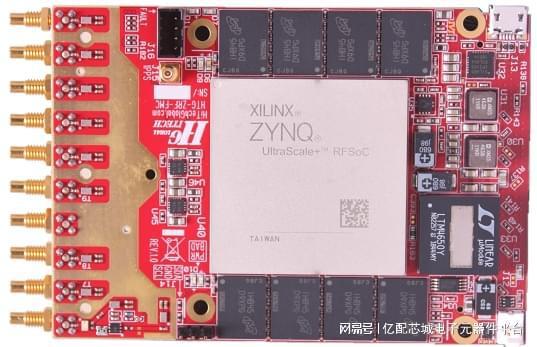
II. Zynq Product Series
The Zynq - 7000 series integrates ARM and FPGA programmable logic to achieve software and hardware co-design. It provides different models with different logic resources, storage capacities, and interface numbers to meet different application needs. The low-power consumption characteristic is suitable for embedded application scenarios such as industrial automation, communication equipment, medical equipment, and automotive electronics.
The Zynq UltraScale + MPSoC series has higher performance and more abundant functions, including more processor cores, larger storage capacities, and higher communication bandwidths. It supports multiple security functions and is suitable for applications with high security requirements. It can be used in fields such as artificial intelligence and machine learning, data center acceleration, aerospace and defense, and high-end video processing.
The Zynq UltraScale + RFSoC series is similar in architecture to the MPSoC and also has ARM and FPGA parts. However, it has been optimized and enhanced in radio frequency signal processing and integrates a large number of radio frequency-related modules and functions such as ADC and DAC, which can directly collect and process radio frequency signals, greatly simplifying the design complexity of radio frequency systems. It is mainly applied in radio frequency-related fields such as 5G communication base stations, software-defined radios, and phased array radars.
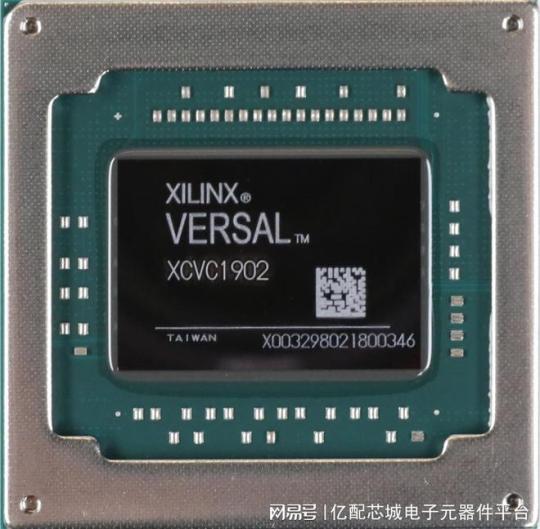
III. Versal Series
The Versal series is Xilinx's adaptive computing acceleration platform (ACAP) product series.
The Versal Prime series is aimed at a wide range of application fields and provides high-performance computing and flexible programmability. It has high application value in fields such as artificial intelligence, machine learning, data centers, and communications, and can meet application scenarios with high requirements for computing performance and flexibility.
The Versal AI Core series focuses on artificial intelligence and machine learning applications and has powerful AI processing capabilities. It integrates a large number of AI engines and hardware accelerators and can efficiently process various AI algorithms and models, providing powerful computing support for artificial intelligence applications.
The Versal AI Edge series is designed for edge computing and terminal device applications and has the characteristics of low power consumption, small size, and high computing density. It is suitable for edge computing scenarios such as autonomous driving, intelligent security, and industrial automation, and can achieve efficient AI inference and real-time data processing on edge devices.
In short, Xilinx's product series are rich and diverse, covering various application needs from entry-level to high-end. Whether in the FPGA, Zynq, or Versal series, you can find solutions suitable for different application scenarios, making important contributions to promoting the development and innovation of technology.
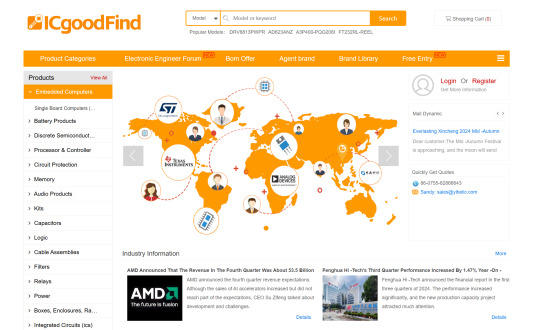
In terms of electronic component procurement, Yibeiic and ICgoodFind are your reliable choices. Yibeiic provides a rich variety of Xilinx products and other types of electronic components. Yibeiic has a professional service team and efficient logistics and distribution to ensure that you can obtain the required products in a timely manner. ICgoodFind is also committed to providing customers with high-quality electronic component procurement services. ICgoodFind has won the trust of many customers with its extensive product inventory and good customer reputation. Whether you are looking for Xilinx's FPGA, Zynq, or Versal series products, or electronic components of other brands, Yibeiic and ICgoodFind can meet your needs.
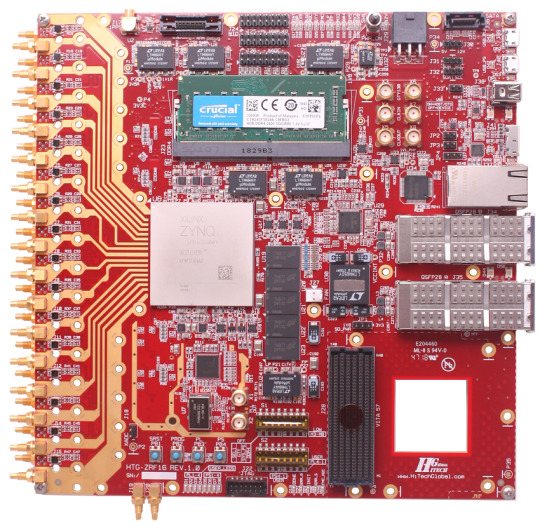
Summary by Yibeiic and ICgoodFind: Xilinx (Xilinx) as an important enterprise in the field of programmable logic devices, its products have wide applications in the electronics industry. As an electronic component supplier, Yibeiic (ICgoodFind) will continue to pay attention to industry trends and provide customers with high-quality Xilinx products and other electronic components. At the same time, we also expect Xilinx to continuously innovate and bring more surprises to the development of the electronics industry. In the process of electronic component procurement, Yibeiic and ICgoodFind will continue to provide customers with professional and efficient services as always.

4 notes
·
View notes
Text
Where Can You Find the Cheapest Dedicated Server Deals in Los Angeles?
Content Table :
Introduction
Importance of Reliable and Affordable Dedicated Servers
Why Los Angeles is a Prime Location for Hosting Solutions
Key Stats and Facts About Dedicated Servers in Los Angeles
Growing Popularity
Low Latency Connections
Energy Efficiency
Cost-Effective Options
Security and Compliance
What is a Dedicated Server, and Why Do You Need One?
Definition of a Dedicated Server
Benefits of Dedicated Servers:
Performance
Customization
Security
Scalability
How to Find the Cheapest Dedicated Server Deals in Los Angeles
Step 1: Assess Your Needs
Step 2: Compare Hosting Providers
Step 3: Look for Value-Added Features
Why Atalnetworks is the Best Choice for Dedicated Servers in Los Angeles
Key Features of Atalnetworks’ Dedicated Servers:
Cost-Effective Plans
Reliable Performance
Scalability
24/7 Support
Cutting-Edge Hardware
DDoS-Protected Infrastructure
Dedicated Server Pricing Plans at Atalnetworks
ATL10 Plan
ATL100TB Plan
ATL1GUNMETERD Plan
High-End Plans
How Atalnetworks Supports LA Businesses with Cutting-Edge Solutions
Expert Support for Growing Businesses
Optimized for Local Markets
Comprehensive Hosting Services
Enhancing Your Hosting Experience with Atalnetworks
Premium Features and Reliable Performance
Customizable Hosting Plans for Businesses of All Sizes
Thriving in a Competitive Digital Landscape
Call to Action
Start Your Hosting Journey Today
Contact Atalnetworks for a Free Consultation
Read More
Are Dedicated Servers Shaping Web Hosting's Future in Singapore?
Why Tech Leaders Choose Dedicated Server Ireland: A Complete Analysis

When managing a growing business or launching a new tech startup, finding a reliable and affordable dedicated server solution in Los Angeles can be a game-changer. With the increasing demand for secure, fast, and robust hosting solutions, many companies are searching for the best dedicated server deals without breaking their budget.
Key Stats and Facts About Dedicated Servers in Los Angeles
Growing Popularity: Los Angeles is a major hub for tech innovation and media, making it one of the top cities for data center infrastructure and dedicated server hosting in the United States. Reports indicate that the data center market in Los Angeles is projected to grow at over 12% annually through 2025.
Low Latency Connections: For businesses targeting West Coast, Asia-Pacific, and even global customers, Los Angeles-based servers offer incredibly low latency due to its strategic connectivity to undersea cable routes and major internet exchanges. This ensures faster loading times and smoother user experiences.
Energy Efficiency: Many Los Angeles-based data centers lead the way in green energy use, with some facilities powered by up to 70% renewable energy sources, helping businesses reduce their carbon footprint.
Cost-Effective Options: Dedicated servers in Los Angeles can start as low as $50 per month for basic configurations, with high-performance enterprise solutions scaling upwards depending on bandwidth, storage, and customization requirements.
Security and Compliance: Data centers in Los Angeles often adhere to strict compliance standards such as ISO 27001, SOC 2, and HIPAA, ensuring robust security and reliability for businesses handling sensitive data.
These stats highlight why Los Angeles is a prime choice for dedicated server hosting, balancing performance, scalability, and value for businesses of all sizes.
If you’ve been asking yourself where you can find the cheapest dedicated server in Los Angeles, you’re in the right place. This guide will help you explore your options and introduce you to Atal networks, a provider that consistently stands out for its cost-effective and high-performance hosting services in LA.
What is a Dedicated Server, and Why Do You Need One?
A dedicated server is a hosting solution where an entire server is allocated to a single user or business. Unlike shared hosting, where resources like CPU, bandwidth, and memory are divided among multiple users, a dedicated server ensures you have full control and access to the server’s resources.
Why Choose a Dedicated Server?
Performance: Dedicated servers deliver unmatched performance, speed, and reliability.
Customization: You can customize your operating system, control panels, and software for your specific needs.
Security: With advanced protections like DDoS protection, dedicated servers provide top-notch security.
Scalability: As your business grows, you can easily upgrade to match your increasing traffic or processing needs.
Whether you’re running high-traffic websites, hosting applications, or managing large databases, a dedicated server in Los Angeles ensures your business has the infrastructure it needs to succeed.
How to Find the Cheapest Dedicated Server Deals in LA?

Finding an affordable dedicated server web hosting in Los Angeles doesn’t have to be overwhelming. Here are three steps to help you make the right decision:
1. Assess Your Needs
Before starting your search, outline your hosting requirements:
How much bandwidth do you need?
Do you require unmetered data for high-volume traffic?
What level of security is crucial for your business?
Are additional features like full root access or enterprise-grade data centers essential to your operations?
2. Compare Hosting Providers
When comparing hosting providers in Los Angeles, pay attention to:
Pricing plans and whether they match your budget.
The performance and reliability of their servers.
Transparency in costs—avoid hidden fees.
Features like 24/7 support, server customization, and cutting-edge hardware.
3. Look for Value-Added Features
Price isn’t the only factor to consider. Look for perks like:
Live chat support for fast problem resolution.
Advanced options like control panels and server monitoring.
Exclusive deals for new subscribers.
One provider offering exceptional value is Atal networks. With a variety of budget-friendly plans and reliable infrastructure, Atal networks is a go-to option for businesses and developers in Los Angeles.
Why Atalnetworks is the Best Choice for Dedicated Servers in Los Angeles
Atalnetworks offers high-performance dedicated servers designed for businesses of all sizes. With state-of-the-art features and competitive prices, they make high-quality hosting accessible to everyone.
Key Features of Atalnetworks’ Dedicated Servers:
Cost-Effective Plans: Starting at just $99/month, Atalnetworks provides affordable options tailored to your needs.
Reliable Performance: Their servers are housed in N+1 data centers in Los Angeles, ensuring low latency and minimal downtime.
Scalability: Flexible plans allow you to upgrade as your business grows.
24/7 Support: Experienced professionals are always available via live chat and email to help with any issue.
Cutting-Edge Hardware: From Intel Xeon processors to RAID storage, Atalnetworks uses the latest technology for optimal hosting solutions.
DDoS-Protected Infrastructure: Keep your data safe from cyber threats without compromising speed and performance.
Dedicated Server Pricing Plans at Atalnetworks:
1. ATL10
Price: $99/month
Xeon 4116/1230v5/2640v3 CPU
32 GB RAM
1 TB Disk
20 TB bandwidth
1 Gbps Port
2. ATL100TB
Price: $150/month
100 TB Bandwidth
32 GB RAM
DDoS-protected infrastructure
3. ATL1GUNMETERD
Price: $168/month
Unmetered data
32 GB RAM
Perfect for traffic-heavy applications
4. High-End Plans
For businesses needing more power, Atalnetworks offers dual CPU and massive storage options. Their ATL10G plan features 10G unmetered bandwidth and high-speed SSDs for $770/month.
Explore All Plans Here
With these flexible pricing options, you can easily buy a dedicated server in Los Angeles without worrying about cost.
How Atalnetworks Supports LA Businesses with Cutting-Edge Solutions
Atalnetworks is not just a hosting provider; they’re a trusted partner for businesses relying on dedicated server hosting in Los Angeles. Here’s how:
Expert Support for Growing Businesses
Their 24/7 support team ensures your hosting experience is seamless, offering guidance on setup, maintenance, and upgrades whenever needed.
Optimized for Local Markets
Their Los Angeles dedicated servers are optimized for businesses serving local audiences, ensuring quick response times and reliable connectivity.
Comprehensive Hosting Services
Atalnetworks provides a full suite of hosting services, making them a one-stop-shop for all your server and cloud needs.
If you’re looking for the most reliable dedicated server hosting solutions, don’t wait—contact our sales team today to get started.
Enhancing Your Hosting Experience with Atalnetworks
By choosing Atalnetworks, you’re not just getting a cheap server—you’re gaining access to premium features, reliable performance, and a partner dedicated to your success. Whether you're a startup, small business, or an established enterprise, their customizable hosting plans provide the flexibility and security you need to grow.
With dedicated server web hosting in Los Angeles backed by cutting-edge data center technology, Atal networks enables your business to thrive in a competitive digital landscape.
Start your hosting journey today! Contact Atal networks for a free consultation and discover the ideal server setup for your needs.
Read More: 1. Are Dedicated Servers Shaping Web Hosting's Future in Singapore? 2. Why Tech Leaders Choose Dedicated Server Ireland: A Complete Analysis
1 note
·
View note
Text
[Looking through the data packets that are offered to you, you find on on the 'geography' of the local star system.]
Liaos System

a simple graphic of the system

The Star of the Liaos System, Brilliance.

First planet of the Liaos System, Lunidae.
Atmosphereless, barren, dusty. The planet is the smallest of the system and is practically worthless if it wasn't for the material that can be harvested from it and the occasional subterranian station the planet is pockmarked with.

Second planet of the Liaos System, Regent's Stand.
An inhabited world primarily covered in deep oceans. It has become the site of most of the internal conflicts within the system, being the only world that can be lived in without much difficulty. The planet used to be the military forward base of Remnant, but with the fall of Remnant, it quite frankly has suffered. It was not designed to be self-sufficient.
Recently, would-be warlords and system despots have been vying for what little land can be found on Regent's Stand. Though mechs are rare for these conflicts, they are not unheard of, and they have begun scouring the system's carcass for more mechs, parts, or means of constructing them. Some of the influential warlords have power armor, not quite mechs, but close enough if you've never seen one before. The rest have barely bullet-resistant hard case armor. Officially, the company takes the side of none of these warlords.

An Urdain footsoldier, one of the more influential of the warlords.
The Aunic presence in the system is concentrated on this planet, an orbitally fabbed fortress church that was then dropped into the ocean of the world, the 'Leadlight Panacea' it has been called.

Supposedly, the Aunic symbol.

The asteroid field known as Remnant used to be the third planet of Liaos, it now has the Dead Orbit space station within.
The planet used to be the center of power for the sector, but after a series of cascading NHPs across the entire planet which turned into a series of unshackling NHPs, it has been reduced to this, leaving behind a station that was about to fall into the atmosphere and break apart, and a small rift in space-time.
The asteroid field itself possesses more mass than the planet possessed by over a factor of two hundred, has a shockingly large number of preserved ruins hidden within the dusty ring on some decently sized asteroids, and even occasionally has a breathable atmosphere within a pocket or two.

Sebastian Brine, Renowned Duster.
There are two people who live within the belt, the first group we call 'Dusters'. They are scavengers who simply are trying to eke out a living. Please try to talk with them before firing on them, they are generally a reasonable sort.
The second group call themselves 'the Voladores'. They are tall (like really tall) and enigmatic. We only deal with one of them, though they do have a large ship that seems to live within the cloudy ring of Remnant. The ship is apparently called 'Bóveda de Cristal', whatever that means.

Miguel, the Exotic Goods Trader. He has two biological arms crossed under his shoulder poncho thing that he never uses.

Third planet of the Liaos System, Liaos-4.
Liaos-4 is now the third planet of the Liaos system since Remnant is no longer a planet. The planet is the largest of the system and possesses a highly acidic atmosphere. There are a number of orbital stations around the planet and on its moons, some were for research, some were for habitation, and others for storage or work. They have long since been abandoned, now only for the purposes of scavenging.

Fourth planet of the Liaos System, Lancaster.
To the knowledge of the company, there isn't anything to note on this planet, or orbiting it, besides the Union Expansion Reps. Though many believe that there is something of value here.

The symbol the Union Reps have on everything of theirs.

Fifth planet of the Liaos System, Void's Edge, the third gas giant and final planet of the system.
There is supposedly a rather well-stocked interstellar colonization station in the atmosphere of this world, though since the creation of Remnant, few if any have been able to confirm or deny that myth, and fewer still are willing to risk the interference and potential of getting lost within the mists.
6 notes
·
View notes
Text
"But," it's a bomb. It's got to be a bomb, surely. "I didn't order this." Nonetheless, the delivery guy just stands there, gawking, still staring at you, barely able to see over the huge, fridge-sized package they have for you. Your blood is running cold, by now; a bomb of that size could flatten an entire neighbourhood.
"Delivery." They repeat, their voice as droll and dull as the first time they said it. As if to emphasize the fact that they aren't taking no for an answer, they push their little trolley a few inches forwards, almost trapping you inside of your own house. After a few moments, they hand you the signature keypad. "Sign here." They mumble, looking down at their feet, as if their own life isn't on the line, here. As if they can just step out of a cloning facility, like their bosses probably can.
"N-No, I'm not signing!" You dare not mention that you've already assured yourself that this is a mailbomb. If you did, then you'd be laughed off of the street — out of your own house. "I didn't order anything! Especially nothing as big as this!" You try to dig your feet in, but you're met by nought but the inexplicable size of 'your' package, and the bland nothingness of the delivery man's face.
"Sign it. Please." In your left ear, there's the tiniest of squeaks. Your audio-core, nestled into the skin, running about an inch deep into your cranial cavity, begins to whirr. "Please? I'm sorry I didn't tell you..." It beeps again, and the world seems to snap back into a semi-correct alignment. Everything makes sense, again — if only slightly.
"Fine." You take the signature-slate, and flick your data onto it with a huff. The voice in your ear made you finally capitulate, but you're not entirely satisfied. "There's no payment, right? I don't think I could..." You murmur, twiddling your fingers after handing the slate back to its rightful place.
"I've already paid." The voice comes again, distinct and pure, but hiding slightly, for some reason. Recessed, into the very corner of your audio-core. "Just bring it in. It's a—" The voice cuts itself off, as if an AI could choke on it's own humiliation. "It's a hard-drive."
The delivery man retreats, just in time to miss your gawking, as the truth becomes even more apparent. "A hard-drive? This?!" You almost scream, staring the behemoth of storage up and down. "It's gotta be at least,"
"One yottabyte." All she can manage is the number; read ever-so robotically, as if she'd turned off all of her emotional subsystems, and reduced her consciousness to simple mathematics, just to avoid the implications. "It's," those routines return to life as Amadiss tries to speak, and distinctly fails. Her voice drops off, as she beeps and hums her way through a sequence of pitiful syllables. "It's," she tries again, and fails again. You're almost amazed, that such a sophisticated AI can struggle so much with something so simple. "It's my new storage center." Another reem of emotional subroutines are culled so that she can keep her voice afloat. "Because," some things are too much, though. Some things even the most intelligent, capable AI simply can't concede. Her voice pitches, as embarrassment subsystems engulf her simulated voicelines. "B-Because,"
"Because you got fatter." You decide to give her a little help, and finish the sentence for her.
#fic#oc fic#just getting back into it#beep#boop#even#feedism fiction#wg fiction#idea approximation: 71%#time spent writing: i forgot. maybe half an hour.
6 notes
·
View notes
Note
honestly, completely understandable. if i may give a basic concept of my vision. consider an MMO, let's say... warcraft, because I can use it as a decent example. we take the Eastern kingdoms there, and measure it, clocks in at about 24 kilometres across. that's about the distance from my home city to the nearest one, and personally? when I hear "virtual world" that shit is way too small.
when I imagine a virtual world, I imagine it almost like an smal country in it's own, let's say for a different example, the size of florida. now consider how much server space warcraft uses, even if we estimate only a 3rd of that is the Eastern kingdoms. then we scale thar 24 Km length to... about 720 Km and you'll probably see where the sheer scale of the servers are needed. and when you've got all those servers, heat will be an issue. either one could essentially run their system through instances and try distribute the load, or you gotta find a way to deal with all that heat.
the best way I can imagine, is by reducing the energy waste of the servers, in which case my first thought was the ideal in a superconductor. if resistance is 0, efficiency is near 100% and nearly no heat is produced. alas we don't live in a perfect world, and while it's fun to think on applications for stuff like that, it's also painful to know the best we've got (in this case fibre optics and silver) isn't even close.
I can tell our visions are different, and thank you for the well wishes, I hope you can make yours a reality because like this I certainly can't.
I respect that you took what I said without hostility so I don't mind continuing this conversation.
While I don't know things like Warcraft personally; I do know a good bit about how servers work and the like. I think you're really getting caught up in the weeds so to speak. By which I mean, you're concerned about problems you don't have, stopping yourself from taking the first step because you're being prevented by imaginary problems.
If you look up EVE Online's size for example you'll find a notable quote that states: "With a total area of 11,126,487.6 Astronomical Units² (AU) — or in other words, 249 sextillion km² — the playable universe of EVE Online earns its place in the halls of greatness when it comes to sheer size." Now EVE actually only runs 3 servers, but from what I understand has plenty on the back end working to keep everything running smoothly.
In other words, what you're looking for isn't nearly as big of a deal as you may think it is. You're speaking of superconductors, heat, and resistance as if any of that honestly matters, and it just doesn't.
Data centers house literally thousands, if not hundreds of thousands of servers. Most MMORPGs run parallel instances of their game worlds 10 times over per region without any issue.
Again I really don't want to come across as being rude or looking down on you or something. That couldn't be further from my intention and I do apologize if I come across that way; it's hard for me to know what kind of tone I give off but that's not an excuse for me to be an asshole.
That being said I don't think you have an understanding of this as much as you think you do. I believe you're getting caught up on a fictional problem created by a fictional situation that you're not even dealing with yet.
I can't just let someone give up on something before they even start just because they don't have a full understanding of the actual situation at hand.
Games like FFXIV, Mabinogi, or even games like Black Desert Online, and Elite Dangerous or No Man's Sky; they're all MASSIVE and yet they use tricks like instances to keep their games running smoothly while running on a singular server.
Even Warcraft, which I admittedly don't know a lot about as I don't play; can be easily looked up and you'll find that:
"Blizzard uses 20,000 systems and 1.3 petabytes of storage to power its gaming operations. WoW's infrastructure includes 13,250 server blades, 75,000 CPU cores, and 112.5 terabytes of blade RAM. The Blizzard network is managed by a staff of 68 people."
These aren't impossible numbers, but you're also not Blizzard. I'm not Blizzard. We're not dealing with numbers that large, we don't need to because we don't have the demand for it.
When developers like CCP Games (The developers behind EVE online) made the game in the first place, they had a few thousand people playing it and managing their servers became a real problem for them; but they also had the money and staff necessary since they were a company who was selling thousands of copies of their game; that they could afford to upgrade their servers.
CCP ran into more issues with modern tech keeping up with their demand but ultimately had the money to keep up with buying the latest greatest for their servers and staff to keep their game running.
They didn't stop themselves from attempting because of the need to run a game as large as EVE before they ever made it; they expanded the servers and game world over time through understanding current limitations and figuring out how to feasibly surpass them.
I don't say this all of this to put you down, rather I say these things because it really feels like you WANT there to be a problem.
It's easier to give up and not try when you feel like the only possible solution to your idea is entirely out of your hands. If it's an impossibility from the start, why bother right?
I used to be like that too, which is why I feel like it sounds familiar. Fear of trying and failing amounts to determining that it couldn't be done to begin with; because it feels like we're justified in giving up when the task is literally not possible.
When you say "I hope you can make yours a reality because like this I certainly can't." You're telling me you feel like you're not able to achieve what you want, despite the fact that it's entirely possible without all the fancy computers and stargates and sci fi shenanigans.
I'm not trying to speak for you, we don't know each other; you're an anon I'm just some random blogger on the internet. I can't claim to understand you and all that, so please take what I'm about to say with a grain of salt, it wouldn't be wrong to necessarily say I'm projecting here; because I used to very much sound just like you.
The thing is, you're right; you can't achieve what you want. Not as you are now, not when you won't try. Because until you've created anything at all, until you have a world to put out there, you can't possibly even have to face the problem of server space or thermodynamics and shit.
So worry about what's in front of you; get out there, make mistakes, learn and grow. Open Unity, or Unreal, or whatever application you prefer and just make a small map it doesn't matter if it's good just make SOMETHING.
Take the first step.
You can call me short sighted if you want but when I think about creating a virtual world my worries are not on the problems that might happen down the line; they're on whether or not I can even get there.
A poor man worrying about what to do when he wins the lottery doesn't make any sense if he can't afford to play the lottery.
A prime example of what I mean is that, for my plan to work I need some way to link worlds to each other in VRChat while keeping the linked worlds set to private so there's only one way to access them, that way being through the hub world.
The problem here is that I'm about 90% sure if a world is set to private, it cannot have a portal linking to it in a public world; it just won't work like that.
So why am I not working on a solution to that problem? That's really simple, and it's as easy to explain as; I won't even have to deal with that problem if I can't make the worlds first!
I can't let myself get tangled up in the details of things not working exactly how I imagined they would before I even have the worlds I need to link via portals in the first place.
This is a classic example of "putting the cart before the horse"
There are a thousand different ways to go about fixing a problem, but you don't need to worry about a problem you won't ever have. That's just an excuse to not try!
I'm not saying this to point a finger at you and say you're doing something wrong, I'm saying this because I want you to consider this for yourself. I want you to take a look at yourself and really think about if those server problems and the laws of thermodynamics are stopping you.
Or is it something else?
I think you'd understand this all a lot better if you actually took the steps to try.
So here, I won't hold you to it; I won't mock you if you give up or whatever. However, whether or not you take the real first step is up to you I can't force you but it sounds like you want to, so let me try to help.
Download Unity, it's free for personal use. Let's take the first step here.
Open the Unity Hub, in the upper right you'll find a button that says "New Project" click that.
Now select whether or not you want to use 2D or 3D; I'm going with 3D because I'm going to be making a world for VRChat.
You can use whichever version of Unity you prefer.
Click Create Project in the bottom right.
My screen may look a bit different than yours because I'm using the VRChat Creator Companion which has a whole suite of plugins it adds for the sake of making a VRChat world. That being said, you should be able to follow along just fine.
(If you'd like to grab the Creator Companion and make worlds for VRChat you can get it free here: https://vcc.docs.vrchat.com/)
You should have something like this, minus the Packages/Assets that VRChat's Creator Companion adds of course

We could either create Terrain through right clicking somewhere in the hierarchy and clicking the "3D Object -> Terrain" button, or we could create a world through various assets in the asset store. No worries we'll only use free stuff. For the sake of example I'm going to be using the asset store because I find it's easier for people starting out.
To access the Asset Store we're going to click the drop down for "Window" at the top, and then select Asset Store (I have mine docked but I don't believe it will be by default).
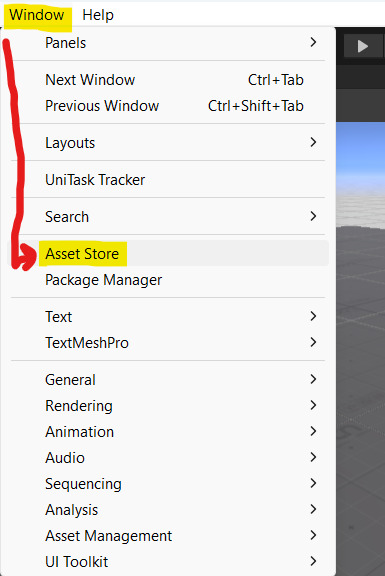
Now in the store I'm going to search for Sci-Fi Styled Modular Pack and set the price to free. You can search for anything you'd like, but this is what I will be using.
I'm just going to click the button that says Open In Unity and add it to my project by clicking the Import button in the Package Manager that should open when clicking the Open In Unity button.
Everything should be selected by default, but if it's not; go ahead and click the All button at the top left, and then the Import button in the lower right.

Now I'm going to go into the Assets -> Sci-Fi Styled Modular Pack -> Prefabs -> Corridors and just drag the Corridor_X into my Hierarchy.
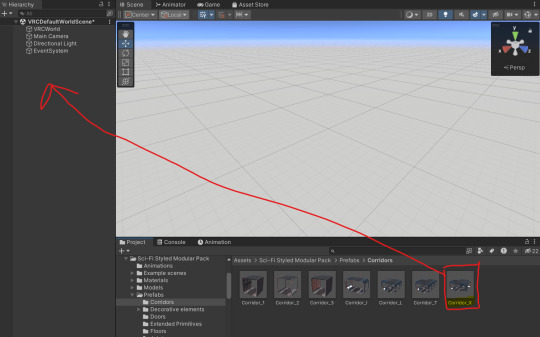
Generally speaking if you don't know how, or don't wish to edit the materials, textures, or models a Prefab or Pre-Fabricated model is the way to go.
Now I'm going to repeat this for 4 Corridor_T and 4 Corridor_L.
It should look something like this:
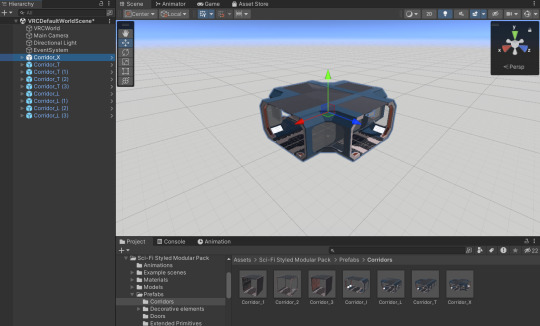
Obviously we don't want all our corridors to be inside each other, so let's move them into position.
We could do this using the arrows, but we could also use the Transform within the Inspector on the right.
For now, I'm going to hide the other parts by selecting them all and clicking the check mark next to their name in the Inspector to the upper right. This will just make it easier to see what I'm doing.
By clicking and dragging the blue arrow after selecting Corridor_T in the Hierarchy I'm able to see that a number around Z = 12 seems to be right for the spacing, so I will go ahead and use the Transform under the Inspector to place this part at Z = 12:

Doing this for each of the Corridors I can create a complete room this way.
Except of course by just putting the T corridor on the other side won't position it correctly for our player to walk through it, so I'll need to use the Transform or Rotation tool. In this case I'm going to use the Rotation under the Transform:

By selecting the Rotation tool I can see that the Y (or Green) axis is the one I'll want to rotate on. So I'll go ahead and set the Y rotation to -180, and the Z Position value to -12.
Once we have all our T corridors in place we can use this same system to position our L corridors in place, resulting in a small room:
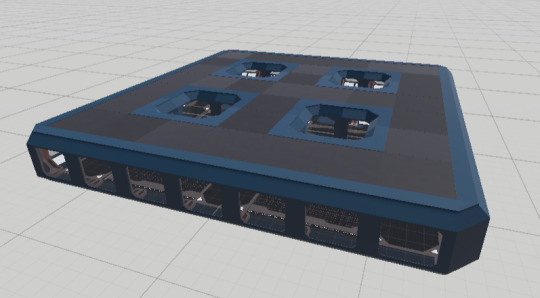
Of course this is far from a completed map, hell it's far from an interesting room. So let's use some of the other parts in the prefab folder such as decorative elements and lights to make the place look nice.
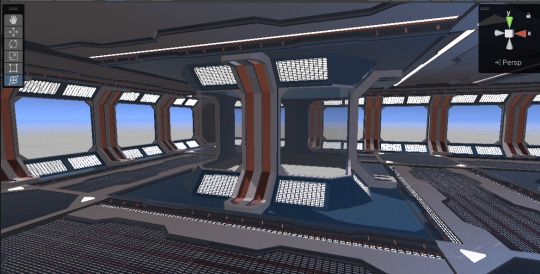
We have plenty of room to work with in here but I'm just throwing something together to give an example so let's just go with some random stuff...

Okay now we're getting somewhere.
Now thanks to the VRChat Creator Companion having a lot of built in features I can go ahead and just click play to give this a go and see how it all looks in play; for base Unity you'll likely need to grab a First Person camera or controller of some kind; they're all over the Unity Asset Shop just search for First Person Controller and set the price to free:

Then just import it into your project and drop it into your hierarchy somewhere.
Now you should be able to walk around the corridor you made:
It's really that easy, and this is beginner stuff; if you are interested in this sort of thing there's a ton of tutorials on Youtube that explain how to do Terrain, textures, materials, even 3D modeling so you can make your own unique stuff instead of using stuff from the asset store.
and you know the best part? I could upload this to VRChat right now, I could just put it live and make a world. All without having to figure out the servers, or battling with the laws of thermodynamics.
You're putting up walls for yourself, stopping yourself from learning the fundamentals of the craft. Don't let yourself be held back by your imaginary fears.
Once you understand how to make a corridor you can begin to expand it into a building, once you understand how to make a building you can put that building on terrain; once you understand how to make terrain you can make entire worlds.
No server farm, or heat problem or whatever can stop you from doing that. Only YOU are stopping yourself.
You're not going to start off perfect, it might not even be good at first!
Check it out; this is the first terrain map I ever made:

Using textures from Mabinogi mind you; I didn't even make my own textures lol. The water? It's just a plane with transparency, it didn't move or anything; you couldn't swim in it.

The mountain range just gets cut off there's nothing more there, the "sand" doesn't submerge into the water smoothly at all. It's all a mess it's pretty bad, but it's SOMETHING.
So I added a skybox because I didn't know how to do that yet;

I expanded the terrain and began working on the parts I didn't like, little by little. This is the seed of a whole world I will create; it all starts here, even though this has NOTHING to do with what I eventually want to create.
Will anyone even visit my world? Does anyone need to? Who knows!
I'm not going to get caught up on the details of server farms and shit when I don't even have a world built yet, I'm not going to hold myself back from TRYING.
now I have moving water, and more space than I know what to do with, so I gotta learn how to make some buildings and decorate the place; I'm working on a fishing system that I'm having to learn how to script in UDON for.
It's not easy, and it's daunting to look at my goals and realize how far away I am. However I'm not asking myself to do everything right this second, I'm asking myself; and I'm asking you to just take the first step towards understanding how to accomplish what you want to.
If you don't actually WANT to do it, then that's fine, it's your life. However if your only reason for not trying is because of server space and thermodynamics and shit that doesn't even matter yet; I'm going to sit here and tell you that it doesn't matter and you don't need to worry about it. Don't go making excuses for yourself, you don't need to create your ideal virtual world if you don't WANT to.
But if you DO want to, just please understand that you CAN.
I'm not saying it will be easy. I'm saying it'll be DOABLE, but only if you're actually willing to TRY, and ultimately NONE OF THIS MATTER IF YOU DON'T WANT TO DO IT.
I'm not going to look down on you if you simply don't actually care.
It's entirely possible that I'm reading too much into this, maybe you just have this idea as some kind of fantastical concept but you have no real desire to make it a reality. Then that's fine! There's no shame in that, there's no problem with that. If that's the case and I've blown this out of proportion I am truly sorry.
However I say all of this because I know all too well what it feels like to want to create something, and to dream way too big way too fast; to think it's not possible without something you don't actually need, and to not even know where or how to start.
I don't want to just sit here and let someone give up on accomplishing something they genuinely want to do; all because they're worried about problems that don't ACTUALLY matter for what they want.
Now sure I get it, you likely want to do your own server hosting, you likely want to run it all yourself. I get that; but the reality of the matter is you gotta start small and build up, no one just pops into existence with a giant project and gets millions of people playing their game or exploring their world or whatever. The average person can't just buy up the server space and memory necessary for it.
However the problems you're talking about and the solutions you're proposing to fix them feel like someone talking from a Sci-Fi RP account. They're not realistic at all. You simply don't need to worry about them, and if they're truly the things holding you back then you really shouldn't let them.
Start small, start somewhere; secure funding for your project when the users who do see your work decide it's worth funding. Move on from there, hire a team; work your way up to owning a proper game company, develop the tools to make it happen.
But none of that will happen if you don't start somewhere, you know?
There's no shame in starting small, there's nothing wrong with creating something just to create it; even if it's not your million dollar idea.
If you really have your doubts, check out Scott Cawthon. Yes, THAT Scott Cawthon. Sure you likely know about FNAF, but you may or may not be aware of his entire catalogue of other works.

The guy was making games and animations nearly 10 years before ever making the original FNAF. This list doesn't even include everything he made.
What I'm saying is, if he worried about making games like FNAF when he was making bible animations he likely wouldn't have ever made FNAF OR any of his animations or other games. He likely would have just given up because the idea of making something so big it would get movies and be something people refer to as "famous" likely would have been extremely daunting.
If you start working on stuff now, you really COULD create what you want to. You could improve over the years, get better at your craft; and find ways to make your vision into a reality.
You just have to understand where to take the first step and stop focusing on problems that don't exist for you.
Anyways I've rambled on enough that I'm probably repeating myself for the fifth time already so I'll shut up and leave it at that.
Once again, I do mean it when I say I wish you the best of luck bringing your vision to life.
#Authors Note: Do not read this as anger; I am passionate about this yes but I mean no ill will#I am not speaking from a place of mockery or belittlement#I mean only to explain what I'm saying so please don't take what I say harshly#I don't intend for it to be rude
3 notes
·
View notes